
 |

|
| |
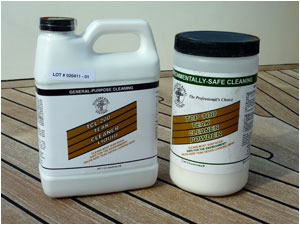
|
|
 |
Day 1,383 - Russell, NZ (35° 15S 174° 06E)
20:11hrs - March 14th 2011
Yard Work |

OK I admit it, I can be a bit of a fusspot - I like things to be a certain way.
And when it comes to our home, Dream Time, I want her to be perfect.
We take good care of her systems and gear, but when it comes to the cosmetics, well, we've had to make a few compromises over the last four years. After-all, cruising in the tropics - the baking sun, salt and humidity are hard work on a boat (and her crew), and it would be a full time battle to try and keep a boat in perfect condition out here. So besides slapping on the regular coats of sunblock (Cetol Marine Light) to protect her teak trim, and putting up sun awnings when we're at anchor, we've had to accept a little wear and tear, hey, it comes with cruising, but is worth the price.
But when it comes to our teak decks, we're in luck, as contrary to popular belief, the less you do to them, the better they'll be. So besides our daily 'watering the garden' routine, where we douse the decks in salt water (to keep them moist and clean), we really do very little. We definitely don't brush them, treat them, oil them, or acid wash them, but what we do do occasionally, about once every year or so, is give them a nice scrubbing, across the grain, with water, a scour pad and Teakdecking Systems' TCP 100.
Made by a company that actually designs and installs teak decks in homes, sailboats, yachts and cruise ships around the world, Teakdecking Systems know their teak, and how to take care of it. So if you want a product that works, is safe for your deck, and more importantly safe for the environment, these guys are decked-out with all the best products.
And if you think this is just a shameless promotion for one of our sponsors, take a look at our deck photos!
Click here to learn more about Teakdecking Systems services and products > |
|

| |
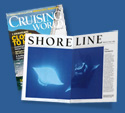
Hot off the press!
Click here to read our
article in the March
issue of Cruising World magazine >
|
|

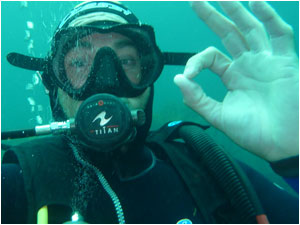
|
|
 |
Day 1,378 - Tutukaka, NZ (35° 37S 174° 31E)
18:02hrs - March 9th 2011
The Poor Knights |

Named after French Toast (Poor Knights Pudding) by James Cook, which the captain enjoyed covered in copious amounts of jam (apparently the pohutukawa trees which cover the islands were in full bloom when he visited, reminding him perhaps that it was time for breakfast), and considered by none other than Jacques Cousteau as one of the top ten dive sties in the world, we couldn't very well just sail past the Poor Knights - a small cluster of wind and wave battered volcanic islands off the east coast of New Zealand, without taking a look.
Although Catherine ultimately decided to stay warm, dry and comfortable on Dream Time, I tugged, pulled and squeezed into fourteen millimeters of neoprene - a two-part wet suit (including hood), strapped on my weight belt, tanks and fins, and with Dive! Tutukaka, set off to explore the kelp covered shoreline of what UK's Dive Magazine ranks as "the best sub-tropical diving in the world."
Home to the world's largest sea cave, the southern hemisphere's largest archway, the only surviving dinosaur (a very resilient lizard), and the world's largest insect, Poor Knights is a unique reserve both in and out of the water, and all manner of creatures have claimed the islands their sanctuary. Including some tropical fish that migrated all the way from Australia, swimming over a thousand miles in the EAC (East Australian Current) just to make Poor Knights their home.
We were briefed by Darren, our kiwi captain for the day, about the islands, their history and about the severe consequences of those found peeing in their rented wet suits. Devoting far more time to this subject than, say, the dive sites, Darren went into graphic detail about what happens to urine inside 14mm of body-heated neoprene during a fifty minute dive, and the punishmnet inflicted on those found wearing a freshly contaminated suit - which involved restraint, a permanent marker and digital camera. His lecture was most convincing and I'd wager that Dive! Tutukaka has the most hygienic wetsuits in the business.
For a total of ninety-six minutes bottom time over two dives, at around twenty meters, I followed Alex, my Mexican dive instructor, like a loyal pilot fish - through swaying kelp forests, into underwater caves and around, over and under boulders, ledges and rocky alcoves. And despite the fact that orcas (killer whales) have been snacking on rays in the area, we sighted sting rays and a few eagle rays, along with a couple of moray eels, plenty of fish and anemones, including some nudibranch's - a tiny colorful sea slug that looks a little like the meaty inside part of a clam.
The water clarity, which is often over thirty meters, was poor due to a strong southeasterly surge caused by a weather trough off the coast, and while the water was a little colder than I'm used to, and we didn't sight any orcas, diving the Poor Knights was still a rich and unique experience, and one that if you find yourselves around Tutukaka on the North Island of New Zealand, is worth a visit.
(Click here to visit the Dive! Tutukaka website) |

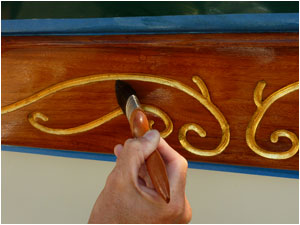
|
|
 |
Day 1,376 - Urquharts Bay, NZ (35° 50S 174° 31E)
11:44hrs - March 7th 2011
How To Add A Little Bling To Your Boat |

Dream Time's thirty-year old teak trailboards, with their original gold leaf scrollwork, have long been in need of a makeover. But as the project requires a dock, specific materials and a lot of patience, it was always rotated to the bottom of our boat project list. That is until recently, when it was literally the last project remaining.
Anyone who owns a boat will know that the moment you've completed all of your projects is indeed rare, and more often than not, short lived. So not wanting to miss my window, and for anyone who perhaps wants to add a little bling to their boat's name plate, here's what we did:
Step1:
Get a gun, a heat gun that is, and strip off all the old varnish and gold leaf, then roll-up your sleeves and start sanding.
Step 2:
When the boards have been thoroughly sanded with 80 - 150 grit, and you're back down to clean teak, wipe them down with some acetone to remove all the surface teak oil, then slap on a few coats of varnish to seal the grain. Four should do it. Try and use a nice thick varnish with good sunblock. I thinned mine down: first coat 50%, second 25%, third 15%, fourth 10%. Sand lightly in between coats with 220 grit.
Step 3:
Give the boards another light sand, wipe them down, then apply the sizing into the areas you wish to gold leaf (sizing is basically an adhesive and if you don't have any use varnish). Apply a thin coat to small areas at a time. When the sizing becomes tacky, almost dry, go to step 4.
Step 4:
So you're not literally throwing gold away, cut the sheets into the approximate size of the area to be filled, then lay the sheet against the sizing and push it gently in to place with a small soft bristle brush. When you peel the sheet away, the gold leaf will be in place. Don't worry if some areas are not covered, repeat this step again to fill all the crack and crannys.
Step 5:
Once all the gold leaf is in place, very gently brush the area with a badger brush to remove all the lose pieces.
Step 6:
Once the sizing has dried, you can tidy up the edges by gently scraping away the
excess gold (I use a small pocket knife to get a clean edge).
Step 7:
More varnish - use a small, soft brush and carefully apply a layer of varnish over the gold leaf.
Step 8:
And still more varnish - another six to eight more coats over the entire boards should do it. Sand lightly between coats of course.
But you're not finished yet: to keep your teak and your gold leaf protected, slap on at least two coats of fresh varnish each year, especially if you're in the tropics. You really don't want to have to do this all over again!

Thanks to our friends Nick and Rachel in America for ordering the packets of
Monarch 23 karat gold leaf for us - cheers guys! |

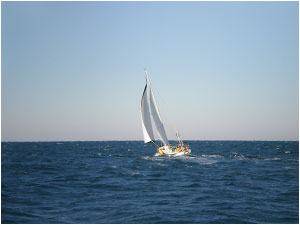
|
|
 |
Day 1,373 - Kawau Island, NZ (36° 25S 174° 50E)
09:01hrs - March 4th 2011
The Right Place |

For the first time since we left New York almost four years ago, we don't know where we're going.
Sure, we'll be sailing back to French Polynesia in about two months, but after that, we've got no idea!
It's not that we've lost our enthusiasm to cruise, or that we're finding it difficult to motivate ourselves to keep exploring, actually it's quite the opposite. You see we're literally spoiled for choice, and perhaps it's taken us this long to really understand what cruising is all about, but we're realizing that we can go anywhere, and that we don't need a cruising itinerary detailing our every port-of-call for the next year. That it's OK to
go backwards, to revisit countries we've already explored, to wander aimlessly, to enjoy the journey, the moment, and to focus a little less on the destination.
We know how fortunate we are to have these choices, the freedom to explore the world, to focus and pursue the things that make us happy. And even though we may not know precisely where it is we're going, we're in exactly the right place. |

|
|








![]()